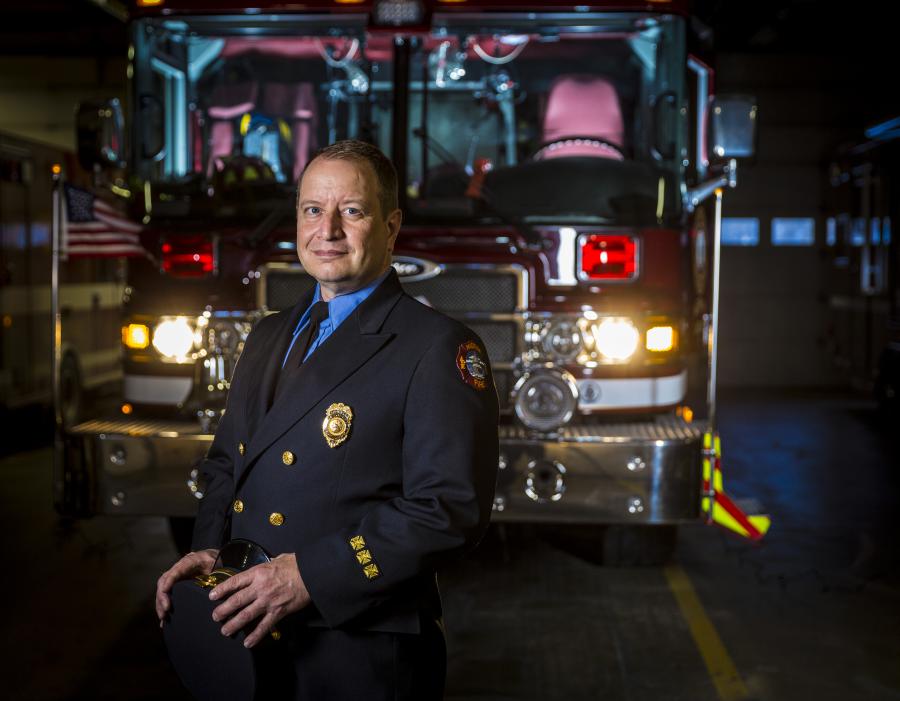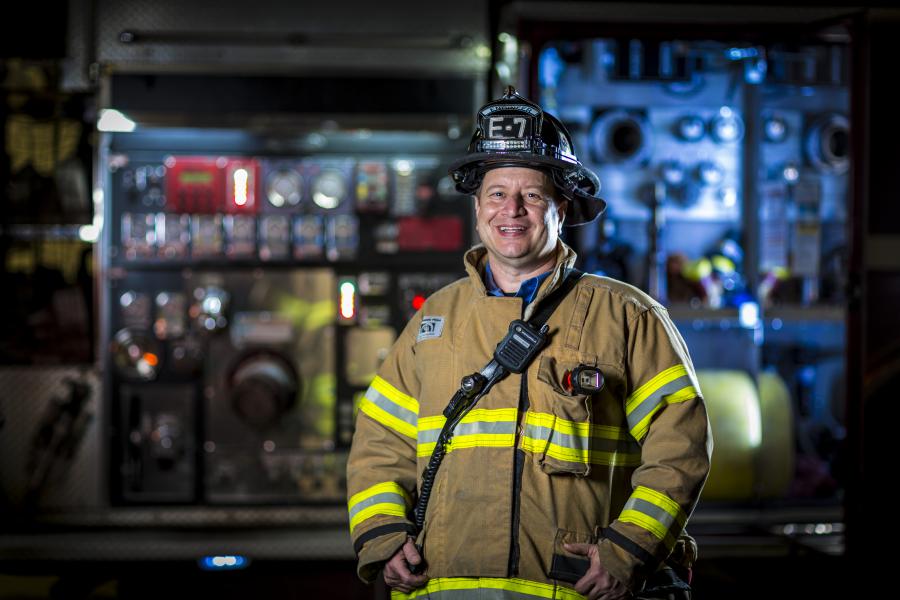MFD Bids Farewell To Retiring Apparatus Engineer Steve Dahlgren
posted
 The new year opens a new chapter for Apparatus Engineer Steve Dahlgren, who retires from the Madison Fire Department today after 25 years of service.
The new year opens a new chapter for Apparatus Engineer Steve Dahlgren, who retires from the Madison Fire Department today after 25 years of service.
For Dahlgren, the path to the MFD was one that came by way of photography. After studying photography and media in Minnesota, he landed part-time jobs with a newspaper, radio station, and television station, eventually clinching a videographer gig with WKOW, Channel 27, in Madison. He spent five years chasing stories and bearing witness to the triumphs and tragedies of life, all the while acquiring skills he would later realized are critical in the job of firefighting and EMS.
“You see people in their highs and their lows (while working in news),” Dahlgren said. “A lot of that is the same with the fire department. When people call us, they’re having a bad day. Somebody’s sick, or they’re sick, or there’s some kind of emergency. When you don’t know what to do, you call us.”
While working at WKOW, he began volunteering on the side, helping produce training videos for the Madison Fire Department. Not long after that, the department took a new approach to Community Education, making new positions available to civilian candidates for the first time in the department’s history.
In 1993, Dahlgren was hired in the first group of civilian Community Education Officers, a position that allowed him to continue working with the local media as a Public Information Officer while also visiting schools and working with businesses on their evacuation and disaster preparedness plans. He was also instrumental in the establishment of Safety Saturday, now a long-standing annual event held at the Capitol Square in June, and in the development of the MFD’s Occupant Services Unit.
Although standing on the periphery of fire scenes—often with a camera in hand—was fun, being part of the action seemed like it could be even more fun. It wasn’t long before Dahlgren started thinking about taking the plunge into firefighting.
“It took me three attempts to get hired as a firefighter,” Dahlgren recalls. “Chief (Debra) Amesqua was the chief then, and she said, ‘I want to know the people we’re hiring.’ In my last interview, I reminded her of her statement and I said, ‘If you didn’t know me after six years of doing this, you’re going to know me better than anybody you ever hired.’ And then I got hired.”
That was eighteen years ago. Since then, Dahlgren has served at a variety of fire stations across the city, starting at Fire Station 8 on the east side. Very soon after that, he was accepted to the MFD’s Hazmat Team and transitioned to Fire Station 6 on W. Badger Road. There he served for about five years before moving on to Stations 2, 12, and 7 (where the Hazmat Team is based today). He maintained his Hazmat certifications and remained a member of the special response team while also serving as an Apparatus Engineer serving “on the road.”
“Hazmat is so encompassing. There are so many different skill sets that you need, and everybody brings to the team a different skill set,” said Dahlgren, who had a particular interest in computer imaging and had a hand in bringing more efficiency and better design to the team’s newest response vehicle.
After years of emergency response, several calls stand out to Dahlgren, but you could say that one of the most memorable calls of his career sort of fell into his lap.
While on duty at Fire Station 5, the crew received a dispatch for an imminent childbirth. The paramedics stationed there were out on a call, and Engine 5 was all alone.
“The couple was just on the way to the hospital and said, ‘I don’t think we’re going to make it,’” Dahlgren remembers. “The dispatcher told them to pull over to Station 5. They pulled in, and within five minutes there was a baby boy there, and maybe five minutes after that the ambulance showed up.”
Soon after, passersby on Cottage Grove Road could see balloons and decorations declaring, “It’s a boy!” on the doors of Fire Station 5. The family returns to the station each year to commemorate the occasion and meet the crews that work there today.
After a while, it can be easy for calls to become routine, but Dahlgren says it's important never to lose perspective or compassion. On one occasion, he found himself in the back of an ambulance as a patient—a reminder of what it’s like to be on the other side of the emergency medical service.
“Now when we go into somebody’s house in the middle of the night and put them in the back of the ambulance, I think about all the things they’re going through for the first time,” he said. “These strangers (who are helping you), as nice as they are, are still strangers.”
With two and a half decades of service coming to a close, you’ll see Dahlgren standing behind a tripod now, not in front of a pump panel. He plans to invest more of his time into photography, as well as traveling and, most importantly, “sleeping through the night.”
As he hangs up his helmet one last time, he reflects on what has been a rewarding career.
“I truly appreciate the fire department, and I loved working here,” said Dahlgren. “I wouldn’t have wanted to do anything else.”

Photo credit: Andy Manis
Subscribe to Fire Blog Updates
Archive
- Fire Sprinkler Week: The Environmental Benefits of Sprinklers
- Fire Sprinkler Week: Where in Your Home Do Fire Sprinklers Need to Be?
- PHOTOS: Heavy Urban Rescue Team Responds to Kettle Moraine for Plane Crash
- Fire Sprinkler Week: Protecting Your Home and Your Drinking Water
- Home Fire Sprinkler Week: How Do Fire Sprinklers Work?
- Asst. Chief (Ret.) Arthur Dinkins III Broke Glass Ceiling for Black Firefighters at MFD
- Lt. (Ret.) Hubert McKenzie's Legacy Carries On Through Lessons Shared
- 'The Dream Is In the Journey' - Catching Up With Paramedic (Ret.) Leotha Stanley
- Firefighter (Ret.) Kat Jackson Reflects on Career, Calls on Black Women to Join the Fire Service
- Meet Firefighter Austin Kuhl
- Meet Firefighter Meredith Brezinski
- Meet Firefighter Kevin Julka
- Community Paramedics Pivot to Testing, Outbreak Response During COVID-19
- Meet Firefighter Diondrae Jenkins
- Meet Firefighter Chris Villanueva
- Meet Firefighter Bree Bower
- Meet the MFD's Newest Firefighters
- Calling All Artists: Fire Station Mural Project Aims to Celebrate the Spirit of the South Side
- Meet Firefighter Dontrell McIntyre
- Meet Firefighter Michael Sepulveda
- Meet Firefighter Allie Feys
- Meet Firefighter Chelsea Utzerath
- Meet Firefighter Heather Seeber
- Meet Firefighter Devin Rogers
- Meet Firefighter Jessie Bowden
- Meet Firefighter Seth Dahmen
- Meet Firefighter Josh Popanz
- Meet Firefighter Ryan Liss
- Meet Firefighter Lexi Wagner
- Meet Firefighter Julie Griessmeyer
- Meet Firefighter Jay Watson
- Meet Recruit Class 8!
- Rick Mulhern, Leader In Technical Rescue and Peer Support, Retires From MFD
- Burn Awareness Week: About UW Hospital's Burn Center
- Burn Awareness Week: Identifying and Treating Burns
- Burn Awareness Week: Sunburn and Frostbite
- Burn Awareness Week: Home Oxygen Safety
- Burn Awareness Week: Preventing Cooking-Related Scalds and Burns
- Meet Firefighter Brennan Boughton
- Meet Firefighter Mike Lothe
- Meet Firefighter Mitch Hanson
- Meet Firefighter Sam Coenen
- Meet Firefighter Marshall Angst
- Meet Firefighter Brandon Courts
- Meet Firefighter Grahm Yahn
- Meet Firefighter Tom Shannon
- Meet Firefighter Joe Parrillo
- Meet Firefighter Ryan Dostalek
- MFD Introduces Recruit Class 7!
- MFD's Community Education Division Teaches Kids To BE AWARE
- LEARN Two Ways Out Of Every Room
- LISTEN For The Sound Of The Smoke Alarm
- LOOK: Fire Hazards May Lurk In Your Home
- First Annual Richard Garner Memorial Ride Raises Over $14,000 For Scholarship Fund
- Meet Lieutenant Zak Smith
- Meet Lieutenant Eric Mills
- Meet Lieutenant Liza Tatar
- Meet Lieutenant David Crossen II
- Four New Lieutenants Assume Position At Area Fire Stations
- National EMS Memorial Bike Ride Pays A Visit To Station 4
- Engine 10 Helps Reunite Mama Duck With Four Stranded Ducklings
- New Aerial Platform Ladder Truck Hits The Road On Madison's West Side
- Show Us Your Smarts: Take the Home Fire Sprinkler Quiz!
- Fire Sprinkler Protection: See the Difference!
- Hiding In Plain Sight: Choosing Concealed Fire Sprinklers
- The Truth About Home Fire Sprinklers
- Seconds Matters: How Home Fire Sprinklers Save Lives
- Meet Firefighter Michael Samosky
- Meet Firefighter Nickolas George
- Meet Firefighter Desmond Leidich
- Meet Firefighter Kyle Kampmeier
- Meet Firefighter Jonathan Clinkscale
- Meet Firefighter John Clooten
- Meet Firefighter McKinnan Stamschror
- Meet Firefighter Ryan Raisbeck
- Meet Firefighter Daniel Ramirez
- Meet Firefighter Brett Bower
- Meet Firefighter Bryce Powell
- Meet Firefighter Daniel Congdon
- Meet Firefighter Larry Moen
- Meet Firefighter Charles Campbell
- Meet Firefighter Casey Endres
- Meet Firefighter Benjamin Nevarez
- Recruit Class 6 Reports For Duty
- New Solar Panels Installed At Fire Station 12
- Fire Prevention Week: Easy-To-See House Numbers Help Us Find You Faster!
- Fire Prevention Week: Practice Your Escape Plan!
- Fire Prevention Week: How To Make A Home Fire Escape Plan
- Fire Prevention Week: Every Second Counts -- Know 2 Ways Out!
- Now Accepting Firefighter Applications!
- CampHERO for Women Coming Up Saturday!
- Madison Launches 'PulsePoint Verified Responder' Pilot Program
- Meet Lieutenant Jeffery Vogen
- Meet Lieutenant Chris Hammes
- Meet Lieutenant Wes Ecker
- Meet Lieutenant Chris Carbon
- Meet Lieutenant Linnea Anderson
- Meet Lieutenant Dan Williams
- MFD Introduces Six New Lieutenants!
- Upcoming Community Events!
- ER Docs Dive Into Firefighting During 'Doc Ops Day'
- MFD Lends Helping Hand At Gilbert Brown Football Camp
- Special Delivery: “Beltline Jax” Makes A Grand Entrance
- New Lease On Life: Oregon Man Reconnects With Crew That Helped Save Him
- 235 New Smoke Alarms Move Into Sherman Terrace!
- Captain Todd Steyer Wraps Up A Fulfilling 30-Year Career With MFD
- EMS Q&A: Where can I learn CPR?
- EMS Q&A: Did you know MFD paramedics are also firefighters?
- EMS Q&A: What should I expect after calling for an ambulance?
- EMS Q&A: What’s the difference between an EMT and a Paramedic? How many paramedics are on duty?
- EMS Q&A: Why does a fire truck come when I call for an ambulance?
- Meet Firefighter Maj-Britt Williams
- Meet Firefighter Adam Thimmig
- Meet Firefighter Ruth Savard
- Meet Firefighter Mike Reisman
- Meet Firefighter Trent Meicher
- Meet Firefighter Jonathon McCray
- Meet Firefighter Adam Lesser
- Meet Firefighter Patrick Johnson
- Meet Firefighter Kyle Homan
- Meet Firefighter Joe Gangler
- Meet Firefighter Justin Fehrenbach
- Meet Firefighter Matthew Dykstra
- Meet Firefighter Brandon Douglas
- Meet Firefighter Tamara Dinkel
- Meet Firefighter Marta Darrow
- Meet Firefighter Davy Calkins
- Meet Firefighter Ryan Beckwith
- MFD Introduces 18 New Firefighters!
- A Greener Firehouse: How Fire Station 12 LEEDs the Way
- Meet AE Brad Vogen
- Meet AE Vince Soto
- Meet AE Chad Powell
- Meet AE Daniel Pazurek
- Meet AE Todd Mahoney
- Meet Apparatus Engineer Cole Christenson
- Meet AE Derek Brown
- New Apparatus Engineers Now Serving In Your Neighborhood!
- Dane County EMS Banquet Honors Survivors, Responders Involved In Cardiac Saves
- On This Day In History: The First 911 Call Is Placed In 1968
- PHOTOS: Getting Up Close With The Lake Rescue Team
- Sable Flames "Second Alarm" Benefit Enters Its 24th Year
- Madison's Iranian Community Comes Together To Honor Firefighters
- Building Connections, Inspiring Kids: Engine 12 At Olson Elementary School
- Welcome Home: Cooper's Hawk Returns To Willy Street
- The Results Are In: 91 Donations Collected During the “Never Forget” Blood Drive
- Meet AE Ethan Dade
- Meet AE Wade Raddatz
- Meet AE Lance Radock
- Meet AE Jacob Conner
- Meet AE Dan Smith
- Meet AE Kevin Hembrook
- National Preparedness Month: Special Needs Disaster Planning
- Meet AE Tom Winter
- Meet AE Lori Karst
- MFD Introduces Eight New Apparatus Engineers
- Generous Grant Brings New "Jaws Of Life" Equipment To Ladder 6
- National Preparedness Month: Creating Communication and Evacuation Plans
- National Preparedness Month: Don't Wait. Communicate.
- “Doc Ops Day” Gives ER Docs A Taste Of Firefighter Life
- Two Years After Accident, Family And First Responders Celebrate 'A Miracle'
- Madison Fire Aims To Keep Injuries Well Under Par At PGA Championships
- “It’s Been A Great Ride," Says Retiring Driver John Lucille
- A Thank-You Gift For All To Enjoy
- “Friday Nights At the Y” Returns In 2016
- Meet Lt. Lisa Becher
- Meet Lt. Derek Teff
- Meet Lt. Casey Preimesberger
- Resources For Candidates Preparing For the Physical Ability Test
- Meet Lt. Sue Juedes
- Meet Lt. Ted Higgins
- Meet Lt. Matthew Mialik
- Meet Lt. Michael McCartney
- MFD Introduces Seven New Lieutenants
- Inside The Galaxie: Making Madison's Newest High Rise Safer For All
- Edgewood Students Donate Stuffed Animals For Kids Experiencing Trauma
- Apparatus Engineer "Recon Bob" Says Goodbye After 25 Years Of Service
- New Boat Enhances MFD Lake Rescue Capabilities
- With Gratitude, Division Chief Ron Schwenn Bids Farewell To the MFD
- New Training Technology Aims to Offer Full Immersion, Minus the Risks
- In the Midst Of Transitions, Our Crews Don't Miss A Beat
- Finance Manager Rita Johnson Retires After 44 Years With the City
- Farewell to West District Captain Tom Reiter
- Meet Firefighter Caluster Buie
- Meet Firefighter Steven Foulks
- Meet Firefighter Richard Miyagawa
- Meet Firefighter Joshua Balli
- Meet Firefighter Matthew Boyle
- Meet Firefighter Oscar Castillo
- Meet Firefighter David Bartkowiak
- Meet Firefighter Christopher Staveness
- Meet Firefighter Michael Guerten
- Meet Firefighter Marcus Bobholz
- Meet Firefighter Joshua Ramsey
- Meet Firefighter Michael Olson
- Meet Firefighter Eric Popovich
- Meet Firefighter Paul Schecklman
- Meet Firefighter Brian Tremain
- Meet Firefighter Cameron Gasaway
- Meet Firefighter Vaughn Brockel
- Why We Do What We Do: Remembering the Our Lady of the Angels Fire
- Meet Firefighter Brian Bieganski
- The Madison Fire Department Prepares For Inaugural "Shake the Lake" Event
- The Heavy Urban Rescue Team Practices Life-Saving Skills
- Safety Saturday 2015: A Day In Photos
- Firefighter Fun Day 2015 is Saturday, August 8
- Retired Firefighter Tim Healy Inducted Into Madison Sports Hall Of Fame
- Firefighter Ty Stebbins Sworn In
Categories
- All Posts »
- Emergency Medical Services (24)
- General (399)
- Join MFD (17)
- Station 1 (72)
- Station 10 (73)
- Station 11 (44)
- Station 12 (61)
- Station 13 (50)
- Station 14 (32)
- Station 2 (60)
- Station 3 (70)
- Station 4 (62)
- Station 5 (68)
- Station 6 (64)
- Station 7 (74)
- Station 8 (71)
- Station 9 (63)
- Your Safety (44)
Tags
- A Day In The Life Of A Madison Firefighter
- AASPIRE
- AED Training
- Alix Olson Award
- Awards & Recognition
- Battle Of the Badges
- Black History Month
- Burn Awareness Week
- CampHERO
- Class of 1980
- Community Education
- Community Outreach
- Community Paramedicine
- COVID-19
- CPR Training
- Dane County Public Safety Communications
- Family Events
- Fire Academy
- Fire Engine
- Fire Investigation Team
- Fire Prevention
- Fire Prevention Division
- fire prevention month
- Fire Prevention Week
- Fire Safety School Tours
- Fire Stations
- Fire Training Division
- Firefighter Fun Day
- Firefighter/EMT Recruitment
- Friday Nights at the Y
- Hazmat Team
- Health/Wellness
- Heavy Urban Rescue Team
- Hiring & Promotions
- HIT
- Holiday Safety
- Home Fire Sprinklers
- Inspections
- International Women's Day
- Internships
- Join the Team
- Lake Rescue Team
- Madison Fire EMS
- Meet the MFD
- MFD Behind the Scenes
- MFD History
- MFD Mailbag
- MFD Prevention Division
- National Preparedness Month
- Open House
- Our Lady Of the Angels
- Paramedics
- Peer Support
- Pet Safety
- Public Health
- Public Safety
- PulsePoint
- Sable Flames
- Safety Tips
- Safety Town
- Shake the Lake
- The American Center
- Training & Professional Development
- UW
- UW Health
- Wanda Fullmore Youth Internship Program
- Winter Safety
- Women's History Month
